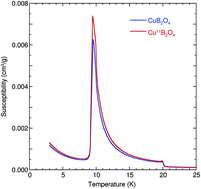Abstract
Copper metaborate had a unique crystal structure and exhibited noteworthy magnetic phase transitions at 21 and 10 K. The electronic structure and lattice dynamics of copper metaborate Cu11B2O4 single crystals were investigated and compared with the optical properties of CuB2O4, to assess the boron isotope effect. The optical absorption spectrum at room temperature revealed two charge-transfer bands at approximately 4.30 and 5.21 eV with an extrapolated direct optical band gap of 3.16 ± 0.07 eV. Compared with the data on CuB2O4, the electronic transitions were shifted to lower energies upon the replacement of a heavier boron isotope. The band gap was also determined to be lower in Cu11B2O4. Anomalies in the temperature dependence of the optical band gap were observed below 21 K. Furthermore, 38 Raman-active phonon modes were identified in the room-temperature Raman scattering spectrum of Cu11B2O4, which were also observed in CuB2O4 with a shift to lower frequencies. No broadening caused by isotopic changes was observed. As the temperature decreased, phonon frequencies shifted to higher wavenumbers and the linewidth decreased. Anomalous softening in the Raman peaks below 21 K was also revealed.

- This article is part of the themed collection: 2020 RSC Advances HOT Article Collection


 Please wait while we load your content...
Please wait while we load your content...